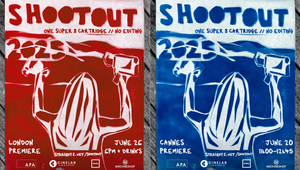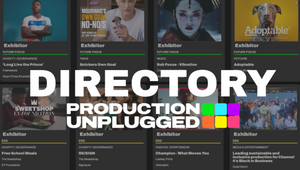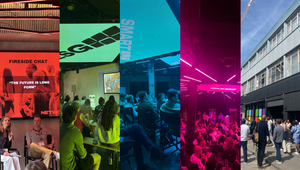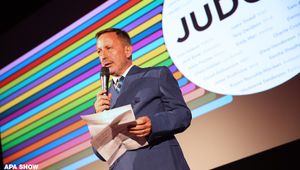
What Does the Future of Advertising Hold in a Time of Extreme Innovation and Challenge

The Future of Advertising (TFOA), an annual event by the Advertising producers Association (APA), returned to London with a bang this year after a pandemic hiatus. The event did not betray tradition and as seen in previous years, brought together talents and experts from across the industry to give them the opportunity to share their insights on what the future of advertising will look like for the year ahead.
From innovative projects and utilisation of new tech to planning and budgeting, the APA aims to provide all the necessary knowledge and prepare industry professionals for the skills that the ever-changing advertising landscape might require from them in the coming months. With unprecedented change - even more so in the last couple of years - come unprecedented challenges. But luckily, ad folk are exactly the people to get excited by a challenge.
That is the case for one of the most pressing issues on the table – climate change. Woven through all the talks at this year’s TFOA was the theme of ‘sustainable production’ and the duty the ad industry has when it comes to the push against climate change. In combination with that, the industry naturally realises the changes that the pandemic has posed, but also the silver linings in terms of sustainable production that it has pushed for. Less travel, less energy consumption and less unnecessary budgeting – all part of the silver glow behind the cloud of the pandemic.
So how can the industry take those learnings and utilise them for a better future as we all aim to move towards a net-zero world? A question that all the TFOA talks seemed to have in mind - and naturally, new tech came into the conversation numerous times. Be it the implementation of the metaverse in the best ways possible within production or the best usage of virtual production, it seems that the general moods point to a world in which production will carry with itself the utilities of innovation for a long time in the future, pandemic or not.
Starting off strong with the theme of sustainability, The Glue Society’s Jonathan Kneebone, Revolver’s Michael Ritchie and Clemenger BBDO’s Sonia von Bibra came together on stage to talk about how meaningful collaboration achieves the unachievable. Their most ambitious and equally experimental project to date, ‘Earth’s Black Box’, meant to record and store climate change data, was the topic of discussion.
Meant to record every step that humanity takes when it comes to tackling climate change, the black box took two years in the making and is situated on the west coast of Tasmania where it will hopefully act to hold governments accountable and record crucial historical developments on the most serious challenge humanity is to face thus far. Starting off as a small press release in December, expected to get a tiny bit of local news, the Black Box ended up in the New York Times, CNN, BBC and various international organisations, according to Michael Ritchie.
Although facing challenging budgets, Sonia explains that experiential campaigns like these face creatives with multiple unknowns, which is “scary” for both clients and creatives - but can be executed beyond expectations through passion and impeccable collaboration. “We loved the simplicity of the black box,” explains Sonia, “but of course, the making of it is where the complexity comes in. It’s been a challenging and really exciting two years to date and we are just beginning.”
Talking about the complexity of the creation of Earth’s Black Box, Michael says: “We needed to build something that’s indestructible, that will survive the test of time and will store data. But the more we explored the origins of an aircraft’s black box, the more we realised that there is a real difficulty to that. In a sense, the goal of this box is to get a real picture of what exactly is happening, but also engage audiences in that conversation. We are starting to think about the end of the planet in a way that we haven’t previously and explore it rather than just reject it entirely. So the timing of this project was very vital and present.”
Followed by the breakdown of this project that not only looks into the future but promises to record the past and allow future generations to learn from our mistakes today, Darren Khan from Clickon Group EMEA and founder of Travlrr alongside James Niklasson from The Mill took the stage to keep the theme of sustainability and climate awareness. Their talk acknowledged that each year, the production industry generates thousands of tons of waste and waste emissions, despite having access to tech that could make the majority of production carbon-neutral and zero-waste.
Specifically looking at the automotive market and how different approaches to production can allow for greener production, James Niklasson provided an example of six Land Rover ‘Above & Beyond’ films – some of them shot in Iceland and some through CG, all done with sustainability in mind. The results were that removing travel and removing the car as a subject (which naturally removes the transport of the car), resulted in 83% less carbon emissions, 30% less cost, 33% increase in delivery speed and 50% less personnel days. In conclusion, the three main solutions to producing only a fraction of the emissions of a traditional shoot are: using bespoke shot background plates and local talent, utilising stock footage as a base element and creating fully CG generated content that provides hyper-realistic results.
“Solutions like these are changing the nature of production. We’re not suggesting you shouldn’t go off and shoot, but we are offering sustainable ways to do it. But also when it comes to the automotive industry, the CG footage used and created can be reused in different ways. The way this can evolve is that shoots can transcend borders much easier through that already generated content,” explained James.
Those trends and solutions have naturally been accelerated during covid, so how long will they stay and will we actually learn to utilise them in the best way possible? A question that later took place during the talk between Chris Chaundler, Ben Sharpe, Rachel Stones and Chris McKenna. Together they took an in-depth look at the opportunities and challenges that new technology presents when it comes to traditional production. Creative borders disintegrating, budgets being an issue, timelines, talent and sustainability were all discussed as part of the talk.
Kicking off with the positives of virtual production, Chris reminded that it offers a range of creative solutions – shooting at an unavailable location, putting together talent that is oceans apart or just plainly doing the impossible from a production perspective. “And from a director’s perspective, if I don’t ever see a green screen again, it will be too soon,” he added.
To Rachel Stones, from Epic Games, the usage of virtual production is a great gateway to the Metaverse. “The ability to real-time render is a gamechanger in advertising and is the foundation of the Metaverse, which has to work on a game engine, so it opens your mind to what that might mean,” she explained. Creating assets in 3D and generating linear content with it after is essentially allowing us to do what we already do, but in a different way and liberating talented directors and DPs to shoot in a more naturalistic way. “To film against a green wall seems crazy if there is a medium that allows a better result from your talent, even if it is just the evolution of that green screen on a base level. It’s a natural progression of things.”
Ben agrees: “It is here to stay and should be used as the right tool for the right time. Using it in the right way in the right time, for example, right now car shoots are the biggest no-brainer with this.”
So we can definitely see, from a business perspective, the innovation in technology is definitely enhancing production for the better, but also plays into the discussion about advertising’s duty to do good. Later in the afternoon, Melda Simon, lead for the #Unstereotype Alliance at UN Women, took to the stage to talk about how advertising can change the course of history, not only when it comes to a net-zero world, but also a world without prejudice and with equal opportunities for all. Joined by UM London’s Michael Brown, Michael Hanbury-Williams and Lydia Van Den Dries, they explored the power advertising and content have to make a positive difference in society.
From the way ads and content are produced, to the way they portray people’s identities, right through to the actual media and formats in which they reach audiences, they explored the opportunities to make a positive difference and why now is the time to seize them.
UM is committed, through its newly launched Better World Media concept, to being a force for good in society, with three main pillars – people, society & industry, and environment. It works within four key aspects towards Ethical Ads and Content, namely the media we use, the content itself, the way we make ads and content and how we portray the people in those ads and content. “In lots of different ways the problems regarding our environment and societies are worsening,” explained Michael. “Hate crime is steadily increasing year by year and advertising has a really important role to play in trying to stem some of that.”
This is exactly why, through the Better World Media Partner Directory, the UM is aiming to support either diversely-owned partners or those who actively stand up for equality. The vision behind Better World Media aims to harness the ability, influence and privilege that agencies have to make a positive impact in the world, as well as provide clearer and more transparent guidance to clients about how to make more ethical choices through media.
With this, comes the conversation about women’s role in advertising. With campaigns opening up to the period conversation, placing women as main characters and giving more agency to disabled folk, the ad industry is definitely making some steps towards bettering the biased decisions it was taking just a few years back. However, according to Melda from UN Women and the #UNstereotype alliance, there’s much more to be done. Watch below:
Beyond climate change and equality - both of the main issues standing in the future of advertising - the event paid its due diligence to the rise of NFTs and the entrance of brands into the metaverse. Answering questions like, ’Are NFTs likely to be an essential part of advertising campaigns moving forward?’, and ‘What even really are NFTs?’, Mike Saraswat, founder & CEO of Ekstasy, explained the inner workings of creating NFTs for brands and incorporating them into production pipelines.
Nexus Studios’ BAFTA and Emmy winning creative director Kim-Leigh Pontin, opened up the conversation about XR experiences and how Web3 is on its way of changing not only branded content online, but out of home advertising - beyond just owning a VR headset. Simplifying the metaverse is definitely something advertising should be aiming at, especially when it comes to accessibility and connectivity in the coming year.
This, alongside making AI work for you as a transformative power in communications, building brand relationships and simplifying budgets are all the pros awaiting the industry after a long period of confusion. It seems like innovation, collaboration and disruptive thinking will be on our side when stepping into these new ways of communication. With climate change becoming an unprecedented issue and the pandemic accelerating technological innovation, it looks like adworld is in for a wild ride of problem-solving like never before that will open doors to boundless creativity.













